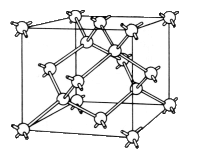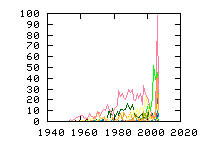« Previous
1
Next »
(12 hits, 1/1)
Showing
10, 25, 50, 100, 500, 1000, all papers per page.
Sort by:
last publication date,
older publication date,
last update date.
- 1. Phys. Rev. B 77, 195204 (2008) , “Identification of antisite carbon split-interstitial defects in 4H-SiC”, J. W. Steeds, W. SullivanA rich variety of optical centers with high energy local vibrational modes has been found in electron-irradiated 4H-SiC in both the as-irradiated and annealed states. These energies have been measured and the annealing dependence of the optical centers has been investigated by low-temperature... (Read more)
- 2. Phys. Rev. B 77, 195203 (2008) , “Creation and identification of the two spin states of dicarbon antisite defects in 4H-SiC”, J. W. Steeds, W. Sullivan, S. A. Furkert, G. A. Evans, P. J. WellmannThis paper deals with the positive identification by low-temperature photoluminescence microspectroscopy of the two spin states of the dicarbon antisites in 4H-SiC. The defects are created by high-dose electron irradiation at room temperature or by subsequent exposure to intense 325 nm radiation at... (Read more)
- 3. Phys. Rev. B 75, 115418 (2007) , “Early stages of radiation damage in graphite and carbon nanostructures: A first-principles molecular dynamics study”, Oleg V. Yazyev, Ivano Tavernelli, Ursula Rothlisberger, and Lothar HelmUnderstanding radiation-induced defect formation in carbon materials is crucial for nuclear technology and for the manufacturing of nanostructures with desired properties. Using first-principles molecular dynamics, we perform a systematic study of the nonequilibrium processes of radiation damage in... (Read more)
- 4. Phys. Rev. Lett. 98, 015501 (2007) , “First-Principles Simulations of Boron Diffusion in Graphite”, I. Suarez-Martinez, A. A. El-Barbary, G. Savini, and M. I. HeggieBoron strongly modifies electronic and diffusion properties of graphite. We report the first ab initio study of boron interaction with the point defects in graphite, which includes structures, thermodynamics, and diffusion. A number of possible diffusion mechanisms of boron in graphite are... (Read more)
- 5. Phys. Rev. B 73, 161201(R) (2006) , “Thermally stable carbon-related centers in 6H-SiC: Photoluminescence spectra and microscopic models”, A. Mattausch, M. Bockstedte, O. Pankratov, J. W. Steeds, S. Furkert, J. M. Hayes, W. Sullivan, N. G. WrightRecent ab initio calculations [Mattausch et al., Phys. Rev. B 70, 235211 (2004)] of carbon clusters in SiC reveal a possible connection between the tricarbon antisite (C3)Si and the U photoluminescence center in 6H-SiC [Evans et al., Phys. Rev. B 66, 35204... (Read more)
- 6. Phys. Rev. B 73, 033204 (2006) , “Electrical characterization of metastable carbon clusters in SiC: A theoretical study”, A. Gali, N. T. Son, E. JanznFirst-principles calculations carried out in 3C- and 4H-SiC show that small metastable carbon clusters can be created in irradiated SiC. The metastable carbon clusters possess occupation levels in the p-type as well as in the n-type 4H-SiC. Depending on the... (Read more)
- 7. Phys. Rev. B 70, 235211 (2004) , “Structure and vibrational spectra of carbon clusters in SiC”, Alexander Mattausch, Michel Bockstedte, and Oleg PankratovThe electronic, structural, and vibrational properties of small carbon interstitial and antisite clusters are investigated by ab initio methods in 3C- and 4H-SiC. The defects possess sizable dissociation energies and may be formed via condensation of carbon interstitials, e.g.,... (Read more)
- 8. phys. stat. sol. (a) 168, 73 (1998) , “Self-Interstitials in Silicon Irradiated with Light Ions”, B. N. Mukashev, Kh. A. Abdullin, Yu. V. Gorelkinskii.The behavior of self-interstitials in silicon which was irradiated with light ions (protons and -particles) and electrons was explored by monitoring known impurity interstitial centers (Ci, Ali, (Si-O)i) with deep level transient spectroscopy (DLTS) and electron... (Read more)
- 9. Jpn. J. Appl. Phys. 32, L1715 (1993) , “Carbon-Induced Rapid Annihilation of Thermal Double Donors in Czochralski Silicon Studied by Infrared Absorption Spectroscopy ”, Yoichi Kamiura*1, Yutaka Uno*2 and Fumio HashimotoCarbon-rich Czochralski Si shows anomalously rapid annihilation for all the species of thermal double donors at 470°C in two stages, which have good time correlations with the decrease of substitutional carbon density and also with the formation of two kinds of carbon-related new donors which... (Read more)
- 10. Phys. Rev. B 42, 5759 (1990) , “EPR Identification of the Single-Acceptor State of Interstitial Carbon in Silicon”, L. W. Song and G. D. WatkinsAn EPR center labeled Si-L6 is reported which is identified as arising from the singly ionized acceptor state of isolated interstitial carbon (Ci-) in electron-irradiated crystalline silicon. Correlated deep-level capacitance transient spectroscopy measurements locate the... (Read more)
- 11. Phys. Rev. Lett. 36, 1329 (1976) , “EPR Observation of the Isolated Interstitial Carbon Atom in Silicon ”, G. D. Watkins and K. L. BrowerAn EPR spectrum, labeled Si-G12, is identified as arising from an isolated interstitial carbon atom in silicon. A ?100? C-Si interstitialcy model is suggested for the defect in which a silicon and carbon atom pair partially share single substitutional site. Because carbon is isoelectronic with... (Read more)
- 12. Phys. Rev. B 9, 2607 (1974) , “EPR of a Jahn-Teller distorted (111) carbon interstitialcy in irradiated silicon”, K. L. Brower.An electron-paramagnetic-resonance (EPR) study of irradiated, p-type silicon doped with carbon enriched with 13C has revealed that the Si-G?11 spectrum possesses a 13C hyperfine structure. Owing to the complexity and lack of resolution in the observed spectrum, we found it... (Read more)
« Previous
1
Next »
(12 hits, 1/1)
Showing
10, 25, 50, 100, 500, 1000, all papers per page.
Sort by:
last publication date,
older publication date,
last update date.
All papers (3399)
Updated at 2010-07-20 16:50:39
Updated at 2010-07-20 16:50:39
(view as: tree
,
cloud
)
| 1329 | untagged |
Materials
(111 tags)
Others(101 tags)
Technique
(46 tags)
Details
(591 tags)
Bond(35 tags)
Defect(interstitial)(18 tags)
Defect(vacancy)(15 tags)
Defect-type(19 tags)
Element(65 tags)
Energy(8 tags)
Isotope(56 tags)
Label(303 tags)
Sample(17 tags)
Spin(8 tags)
Symmetry(15 tags)

